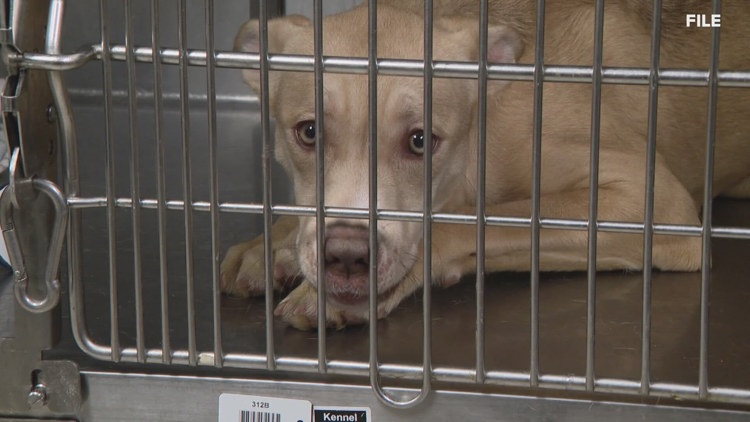5 On Your Side is examining the future of St. Louis County Animal Care and Control following the euthanasia of 19 dogs during a Parvo outbreak.
The veterinarian in charge who approved it has since been replaced. Now, the county executive is seeking over $17.5 million from the Rams’ settlement funds to significantly renovate the facility.
The county is now managing its own animal shelter once more. The Animal Protection Association (APA) had been in charge but chose to discontinue the partnership last Fall.
Several months later, a case of Parvo occurred. The shelter also failed three rounds of inspections before regaining its license. The county’s health director – who only met with 5 On Your Side – stated that after everything that has happened this year, they are making improvements.
Of course I didn’t support that number of dogs being put to sleep,” Dr. Kanika Cunningham stated. “It was heartbreaking.
Cunningham is speaking out about the euthanizations that her former veterinary director carried out at the county’s animal care and control shelter in Olivette.
“There were three or four dogs that I knew were actually deteriorating,” she said.
A Parvo outbreak began in April and spread rapidly. What initially involved only a few dogs being euthanized soon increased to 19. Cunningham stated that the veterinary director carried out the action without her awareness. In May, Douglas Pernikoff resigned.
You’re going to encounter some (Parvo) at a shelter,” said animal welfare advocate Shannon Latzke. “It’s present in the environment. It’s in the soil. It can survive in the soil for a year… but for it to spread like it did to so many dogs?
He mentioned that the illness can be managed with appropriate resources.
“The conventional approach that has consistently been considered the best is when they are admitted to a veterinary clinic and receive fluids along with supportive care. We monitor their diet and other related factors, as well as administer various medications. This method has a very high success rate,” she added.
Latzke also highlights alternative solutions, such as temporary foster care until the animals recover. The shelter’s previous veterinary director informed county council members that essential medication was too expensive and isolating the first dog when it became ill was challenging.
“They began using a garage as a location for isolation. It was the only area we could access to keep the dogs apart, and naturally, we continued to bring in additional animals, which led to us having to use the hallway at times,” Cunningham said.
The Health Director states that the outbreak highlighted the necessity to reconsider certain aspects. “We gained significant insights. We lack appropriate isolation or quarantine facilities… We didn’t have immediate access to medications or the necessary equipment to administer subcutaneous IV fluids.”
St. Louis County Executive Sam Page is currently trying to persuade the county council to approve $17.8 million in Rams settlement funds to tackle essential requirements, including upgrades to infrastructure, renovating the veterinary office and examination areas, and constructing bigger kennels. While the shelter waits for the council’s decision, Cunningham has already developed a strategy.
“We conducted simulated inspections. During every staff meeting, we ensured all employees were informed about correct kennel space and dimensions…. When individuals bring in dogs, we must verify they are placed in appropriately sized kennels. We have faced citations for this in the past,” Cunningham stated.
She also mentioned that there are currently enhanced protocols in place to thoroughly clean and disinfect the shelter.
Cunningham mentioned that, in various aspects, the department (shelter) experienced a significant transformation.
“You do have some of our long-term employees who have chosen to leave because they disagree with the path we’re taking,” she said.
It’s the cost incurred when changing direction. A fresh feeling of resolve and purpose now motivating the effort to get back on course.
“I won’t be leading a health department that isn’t delivering quality care, regardless of whether it’s for humans or animals. I simply won’t return there,” Cunningham stated.
Another issue they are tackling is when staff fail to vaccinate newly arrived animals prior to their exposure to existing animals in the shelter.
Cunningham also mentioned that there is a strong emphasis on acquiring morevolunteers. They also recently introduced afoster program to help ease overcrowding.
If an animal shelter in Missouri does not pass its first inspection, it is given two additional inspections within a maximum timeframe of 90 days to meet the requirements. To obtain a license, the shelter must successfully pass these inspections; otherwise, it will be operating illegally.
5 On Your Side asked about St. Louis County’s euthanasia rates from previous years to now:
- From November 2019 until November 2022, euthanasia rates averaged 6.32%.
- From December 2022 until February 2025(under APA administration), the average euthanasia rates were13.2%
-
From March 2025 until May 2025 , euthanasia rates averaged 12.45%







